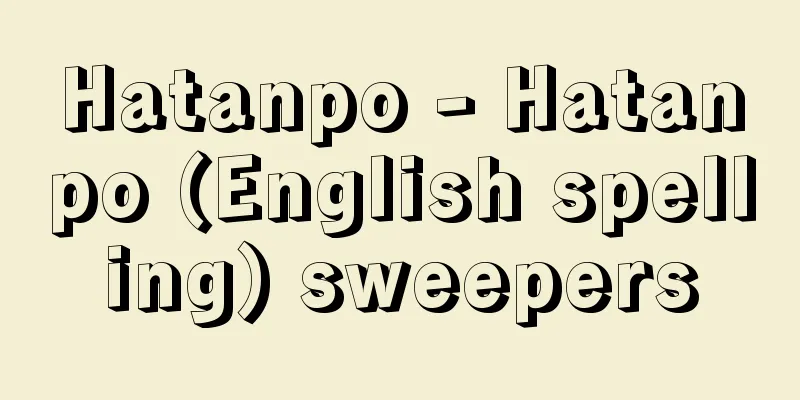Hatanpo - Hatanpo (English spelling) sweepers

|
A general term for marine fishes belonging to the family Pempheridae, order Perciformes, class Osteichthyes, or genus Pempheris . They live in schools in shallow rocky areas facing the open ocean, and occasionally in brackish waters, in the tropical and temperate zones of the Pacific, Indian, and western Atlantic Oceans. They gather in groups in caves during the day and disperse at night to feed on crustaceans and polychaetes. They reach a total length of about 30 centimeters. The body is laterally compressed, and in many species the height is highest in the thorax and drops sharply in a straight line toward the caudal peduncle. The eyes are remarkably large, with the eye diameter being considerably larger than the snout length. The mouth is somewhat large, with the rear end of the upper jaw reaching below the center of the eye. There are small teeth on both the upper and lower jaws and on the palate. There is one dorsal fin with a short base, located almost in the center of the body. They have 4-7 spines and 7-12 soft rays, and the spines grow gradually longer toward the rear. The anal fin is low and has a significantly long base. Many species have light-emitting organs in the abdomen associated with the pyloric caeca or rectum, which appear to absorb light-emitting substances from food. The family Parapriacanthus consists of two genera: Parapriacanthus , which has a low body height of 36% or less of its body length, and P. pacifica, which has a high body height of 39% or more of its body length. It is a small family with only 26 species recorded worldwide. According to a paper by Japanese ichthyologist Keita Koeda (1986- ) in 2017, seven species of Parapriacanthus are known from Japan: P. japonica , P. adusta , P. schwenkii , P. nyctereutes , P. oualensis , P. ufuagari , and P. vanicolensis . [Masao Katayama and Kunio Amano, February 17, 2021] [Reference] | |Source: Shogakukan Encyclopedia Nipponica About Encyclopedia Nipponica Information | Legend |
|
硬骨魚綱スズキ目ハタンポ科Pempheridaeあるいはハタンポ属Pempherisに属する海水魚の総称。太平洋、インド洋および西大西洋の熱帯から温帯にかけて、外洋に面した海の浅い岩礁地帯、まれに汽水域に群れをなしてすんでいる。日中は洞穴などで群れていて、夜になると分散して甲殻類や多毛類などを食べる。全長は30センチメートルくらいになる。体は側扁(そくへん)し、多くの種では体高は胸部でもっとも高く、尾柄(びへい)に向かって直線状に急角度で低くなる。目は著しく大きく、眼径は吻長(ふんちょう)よりもかなり大きい。口はいくぶん大きく、上顎(じょうがく)の後端は目の中央部下に達する。上下両顎と口蓋(こうがい)部に小さな歯がある。背びれは1基で、基底は短く、体のほとんど中央部に位置する。4~7棘(きょく)7~12軟条で、棘は後方に向かって段階的に長くなる。臀(しり)びれは低くて、基底は著しく長い。多くの種は腹部に幽門垂(ゆうもんすい)や直腸と関連した発光器をもち、発光物質を餌(えさ)から取り込んでいるとみられる。 ハタンポ科には、体高が低く、体高が体長の36%以下のキンメモドキ属Parapriacanthusと、体高が高く、体高が体長の39%以上のハタンポ属の2属がある。世界から26種しか記録されていない小さな科である。2017年(平成29)の、日本の魚類学者の小枝圭太(こえだけいた)(1986― )の論文によると、日本からはキンメモドキ属のキンメモドキ1種と、ハタンポ属のツマグロハタンポP. japonica、リュウキュウハタンポP. adusta、ミナミハタンポP. schwenkii、ミエハタンポP. nyctereutes、ユメハタンポP. oualensis、ダイトウハタンポP. ufuagariおよびキビレハタンポP. vanicolensisの7種が知られている。 [片山正夫・尼岡邦夫 2021年2月17日] [参照項目] | |出典 小学館 日本大百科全書(ニッポニカ)日本大百科全書(ニッポニカ)について 情報 | 凡例 |
>>: Bataan Peninsula - Bataan Peninsula (English spelling)
Recommend
Twelve Years' War in Oshu - Oshu Jyuunienkassen
...A war fought between Minamoto no Yoriyoshi, th...
Brynhild
… In the Bolsunga Saga, Siegfried (Sigurðr, Sigur...
People of Quanzhou
A writer of human interest stories from the late ...
Shomyo Falls
This waterfall falls on the Shomyo River, which f...
Crommelin (English spelling) Andrew Claude de La Cherois Crommelin
1865‐1939 British astronomer. He graduated from Ca...
Relative pronouns - Kankeishi
...For example, there may be a small number of sh...
Amacha (sweet tea) - Amacha (English spelling) Hydrangea macrophylla var. thunbergii
A deciduous shrub of the Saxifragaceae family, it ...
Durosum
…A city in northern Bulgaria, on the border with ...
Prostrata
…The Abelia is propagated by cuttings. Some culti...
Shigeno story - Shige Shigeyawa
A reading book from the mid-Edo period. Written b...
Paragraphia
…Intralingual disorders inevitably lead to simila...
Transformation story - Tenshin Monogatari
Ovid's epic poem. 15 volumes in total. It is a...
Yu Fān (English spelling)
164‐233 A scholar of the Three Kingdoms Dynasty of...
light water reactor
…Light water reactor: A nuclear reactor that uses...
Axel
…It is the polar opposite of the faithful reprodu...









